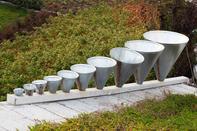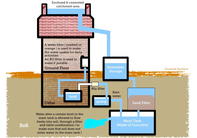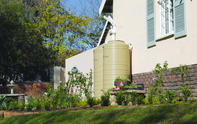Collecting water or ‘rainwater harvesting’ from roofs for household and garden use is widely practised across South Africa - in rural areas and increasing more in cities. This means that every time it rains, water can be collected for use during droughts.

Collecting rainwater decreases dependence on municipal water supply and water storage dams. It also helps to conserve water, reduces flooding and soil erosion and will reduce the water bill. In addition, rainwater is clean and not full of pesticides and chemicals.
How to Collect Rainwater?

Rainwater can be collected from any structure with a roof - house, stables, carports etc. A tank or reservoir is needed to store water and gutters or pipes are needed to channel the water from the roof into the tank.
Tanks can range from large brick reservoirs to drums and plastic buckets. The larger the roof, the larger the tank that will be needed. The best water pipes are UV resistant such as ISI HDPE and PVC pipes. The drains at the ends of gutters should be fitted with wire mesh to prevent leaves and other substances being washed into the tank.
It is recommended to use a first flush water diverter. This is a device diverts the first volume of rainwater with all the dirt from the roof to enter the tanks. The first water coming from the roof after rains may be contaminated with rust, dust, bird droppings and chemicals. The first flush water diverter will improve drinking quality, reduce corrosion of pipes and reduce sludge build-up inside the tanks.
A general guideline recommends first flush devices should remove about 40 litres of water per 100 m² of catchment area. In dusty areas or in urban areas with air pollution, a larger first flush device may be needed.
Maintenance of Rainwater Harvesting Structures

Gutters and roofs should be regularly inspected and kept clean and clear of dust, leaves, animal and bird droppings, dead animals, insects and chemicals. The cleaner the roof and gutters, the cleaner the water.
Clean any filters installed in the pipes or tank inlet. Check your tank for sludge at least every two to three years. Remove it by syphoning it out or completely emptying your tank. Sludge build-up is a sign that the roof and gutters are dirty. Remove build-up of dirt collected on top of the tank.
Source Water Research Commission